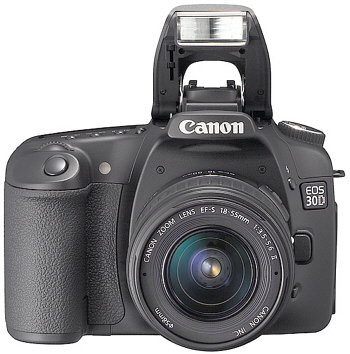
|
A brief commentary on the Canon EOS 30D
 Canon EOS 30D
The release of the EOS 30D has met a mixed response by current 20D owners. On many photography forums people have expressed a sense of disappointment and let down that it doesn't have a 10MP sensor. On the other hand many photographers have greeted it as a definite improvement over the EOS 20D. The sense of disappointment comes from two sources I think. First there was the very widespread expectation (shared by me) that Canon would once again pull a technological rabbit out of the hat and continue with their string of "1st's". The D30 was the first affordable DSLR. The D10 was the fist really good 6MP DSLR. The Digital Rebel was the first low cost DSLR. The 20D was the first affordable 8MP DSLR. The Digital Rebel XT was the first low cost 8MP DSLR. The EOS 1Ds Mk II has the highest pixel count of any DSLR. The EOS 5D was the first (and currenlty only) full frame DSLR selling for under $3000. Given such a track record it was reasonable for people to assume that the EOS 30D would go "one better" than the EOS 20D and up the pixel count to 10MP, matching that of the Nikon D200. Well, they didn't. They made some significant improvements to the EOS 20D, improvements that are certainly welcome and very worthwhile, but they left the sensor at 8.2MP, choosing to use the same sensor as is used in the EOS 20D. I'll get back to the sensor issue later, but for now lets just look at the improvements:
The $64,000 question. Why still 8.2MP?I've no idea, but I think it comes down to one of two reasons. Technical problems or economics.
Technical ProblemsI think Canon could probably make a 10MP APS-C sensor that's as good as the current 8.2MP sensor. They have their own research labs as well as their own engineering and development labs and have lots of experience in making their own CMOS sensors. So I don't think that a 10MP APS-C sensor with good noise performance is eventually beyond their capability, but perhaps it's not currently available. It's notable that current DSLRs with smaller pixels than the EOS 20D/30D (some of the Olympus 4/3 DSLRs and the Nikon D200) have measurably high noise at high ISO settings.EconomicsIt could be that the market researchers said that the best ROI (return on investment) would come from a DSLR priced below $1400 and Canon then developed the best DSLR they could to meet that price.It's also possible that Canon concluded that an increase in pixel count from 8 to 10MP would yield a negligable improvement in image quality for the majority of users, and that an improvement in camera features and a lower selling price would actually give photographers more for their money. Bottom line on the EOS 30DI'd say the EOS 30D gets a "B+" as an upgrade from the 20D, but an "A" as a stand alone camera and an "A" as an upgrade from the EOS 10D or any of the Digital Rebels. It's an incremental improvement of the EOS 20D, but it's not a blockbuster technological breakthrough. Nobody, not even Canon, can do that forever, every single time they bring out a new camera and DSLR technology is maturing to the point where such incremental improvements will become the norm.What to BuyFor a little while at least Canon DLSR buyers have a 3-way choice in APS-C DSLRs. All three have an 8MP sensor and essentially the same image quality. There's the Canon Digital Rebel XT at around $750, the Canon EOS 20D at around $1150 and the Canon EOS 30D at around $1400. Each one adds more features and capabilities, but as I said, each one is capable of producing pretty much equal quality images. It's not certain how long the EOS 20D will be available for, but I'm sure it will be pretty easy to find a new one for a short while.The decision for EOS 20D owners whether to upgrade or not is a personal one. I think the EOS 30D is worth the extra $250 if you're buying new, but if you have to sell your EOS 20D (at a loss) and buy an EOS 30D at $1400, it will probably cost most EOS 20D owners more like $500 or so to do the upgrade (plus the hassle of selling their 20D). $500 would buy a nice lens, so it's really a matter of what you want/need more if you have $500 waiting to be spent!
Further Reading
© Copyright Bob Atkins All Rights Reserved |
||
|
|